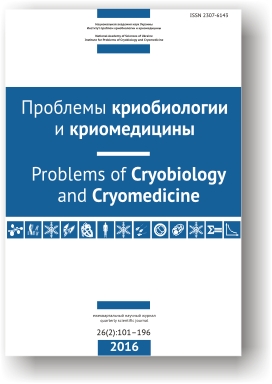Growth Factors BDNF And TGF1β in Tissue of Cryopreserved Human Placental Amniotic Membrane after Antiglaucomatous Surgery
DOI:
https://doi.org/10.15407/cryo26.02.145Keywords:
human placental amniotic membrane, cryopreservation, permeability, cell growth factors, antiglaucomatous surgeryAbstract
The effect of cryopreserved human placental amniotic membrane (HPAM) on the release of cell growth factors BDNF and TGF1β into both an environment and eye within the observation period of up to 21 days has been studied. By enzyme immunoassay there was investigated the content of cell growth factors in ocular tissues after use as a coating of the frozen according two-step regimen HPAM in antiglaucomatous surgery. The efficiency of using the frozen-thawed HPAM in respect of releasing the cell growth factors after its application into the post-surgery defect zone has been demonstrated. There was found the dependence of accumulation of growth factors TGF1β and BDNF on time of cryopreserved HPAM application, eye tissue type and tropism of growth factors.
Â
Probl Cryobiol Cryomed 2016; 26(2):145-154.
References
Grischenko V.I., Yurchenko T.N., editors. Placenta: cryopreservation, structure, properties and perspectives of clinical applications. Kharkov; 2011.
Krivosheina O.P. Proliferative vitreoretinopathy: factors of pathogenesis and development regularities. Vestnik Ofthalmologii 2003; (3): 47–50.
Limb G.A., Chignell A.H., Green W. et al. Distribution of TGF and its reactive vascular adhesion molecules in fibrovascular membranes of proliferative diabetic retinopathy. Br J Ophthalmol 1996; 80(2): 168–173. CrossRef PubMed
Limb G.A., Little B.C., Meager A. et al. Cytokines in proliferative vitreoretinopathy Eye 1991; 5(6): 686–693. CrossRef PubMed
Lipovetskaya E.M. Development of experimental glaucoma with prolonged intravenous administration of adrenaline. Journal of Ophthalmology (Ukraine) 1966; (3): 221–223.
Malova N.G., Demin Yu.A, Kazmiruk I.L. Intrascleral supracilliar implantation of cryopreserved amnion with neuroprotective aim in experimental adrenaline induced glaucoma. Mir Meditsyny i Biologii 2013; 9(4): 71–75.
Mikheytseva I.H. Glaucoma models, advantages and
Mori K., Duh E., Gehlbach P. et al. Pigment epithelium-derived factor inhibits retinal and choroidal neovascularization. J Cell Physiol 2002; 188(2): 253–263. CrossRef PubMed
Samusenko I.A., Alekseev V.N., Abuzayed V.N. Morphological manifestations of therapeutic pathomorphism of glaucomatous optic neuropathy in experimental glaucoma. Glaukoma 2003; 4(21): 32.
Yam H.F., Pang C.P., Fan D.S., et al. Growth factor changes in ex vivo expansion of human limbal epithelial cells on human amniotic membrane Cornea 2002; 21(1): 101–105. CrossRef PubMed
Zolotarev A.V., Milyudin E.S. Surgical treatment of recurrent pterygium with plastics by silico-dried amniotic membrane. Vestnik Oftalmologii 2007; 123(1): 39–42. PubMed
Downloads
Published
How to Cite
Issue
Section
License
Copyright (c) 2020 Irina L. Kazmiruk, Yuriy A. Demin, Vladimir V. Ryazantsev

This work is licensed under a Creative Commons Attribution 4.0 International License.
Authors who publish with this journal agree to the following terms:
- Authors retain copyright and grant the journal right of first publication with the work simultaneously licensed under a Creative Commons Attribution License that allows others to share the work with an acknowledgement of the work's authorship and initial publication in this journal.
- Authors are able to enter into separate, additional contractual arrangements for the non-exclusive distribution of the journal's published version of the work (e.g., post it to an institutional repository or publish it in a book), with an acknowledgement of its initial publication in this journal.
- Authors are permitted and encouraged to post their work online (e.g., in institutional repositories or on their website) prior to and during the submission process, as it can lead to productive exchanges, as well as earlier and greater citation of published work (See The Effect of Open Access).




